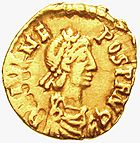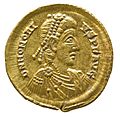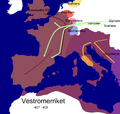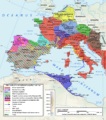Western Roman Empire facts for kids
Quick facts for kids
Roman Empire
Imperium Romanum
|
|||||||||||||||||||||||||||||||
|---|---|---|---|---|---|---|---|---|---|---|---|---|---|---|---|---|---|---|---|---|---|---|---|---|---|---|---|---|---|---|---|
| 395–476/480 | |||||||||||||||||||||||||||||||
|
|
|||||||||||||||||||||||||||||||
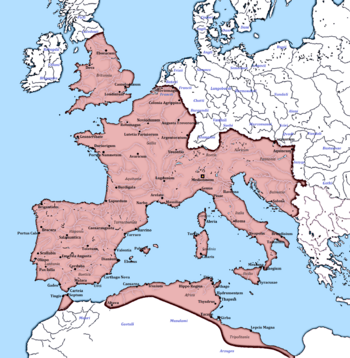
The territory controlled by the Western Roman Imperial court following the nominal division of the Roman Empire after the death of Emperor Theodosius I in AD 395.
|
|||||||||||||||||||||||||||||||
| Status | Western division of the Roman Empire |
||||||||||||||||||||||||||||||
| Capital | Mediolanum (395–402) Ravenna (402–455, 473–476) Rome (455–473) Spalatum (475–480) |
||||||||||||||||||||||||||||||
| Capital-in-exile | Spalatum (475–480) |
||||||||||||||||||||||||||||||
| Common languages | Latin (official) Regional / local languages |
||||||||||||||||||||||||||||||
| Religion | Polytheistic Roman Religion until 4th century Nicene Christianity (state church) after 380 |
||||||||||||||||||||||||||||||
| Government | Autocracy | ||||||||||||||||||||||||||||||
| Notable emperors | |||||||||||||||||||||||||||||||
|
• 395–423
|
Honorius | ||||||||||||||||||||||||||||||
|
• 457–461
|
Majorian | ||||||||||||||||||||||||||||||
|
• 474–480
|
Julius Nepos | ||||||||||||||||||||||||||||||
| Legislature | Roman Senate | ||||||||||||||||||||||||||||||
| Historical era | Late antiquity | ||||||||||||||||||||||||||||||
|
• Death of Emperor Theodosius I
|
17 January 395 | ||||||||||||||||||||||||||||||
|
• Deposition of Emperor Romulus Augustulus
|
4 September 476 | ||||||||||||||||||||||||||||||
|
• Murder of Emperor Julius Nepos
|
25 April 480 | ||||||||||||||||||||||||||||||
| Area | |||||||||||||||||||||||||||||||
| 395 | 2,000,000 km2 (770,000 sq mi) | ||||||||||||||||||||||||||||||
| Currency | Roman currency | ||||||||||||||||||||||||||||||
|
|||||||||||||||||||||||||||||||
The Western Roman Empire was the western part of the Roman Empire. It was formed when the Roman Empire was split in two by Emperor Diocletian in 286 AD. The other half became known as the Eastern Roman Empire.
The entire Roman Empire faced many problems starting around 190 AD. Large groups of Gothic tribes began moving into Roman lands. Rome's leaders were weak, and the government was unstable. Different groups in the Roman armies often tried to make their own leaders emperor. This led to many emperors being murdered. Because of this, the Roman armies could not stop the invasions by Germanic tribes.
Emperor Diocletian tried to make the government strong again. He divided the huge Empire into two main parts. The Western Empire included places like Spain, France, southern Britain, Italy, North Africa, and parts of Germany. The Eastern Empire covered the Balkans, Turkey, the Middle East, and Egypt.
After this division, Rome was no longer the capital city. In 286 AD, the capital of the Western Roman Empire moved to Mediolanum (which is now Milan). Later, in 402 AD, the capital moved again to Ravenna.
Contents
The Fall of the Western Roman Empire
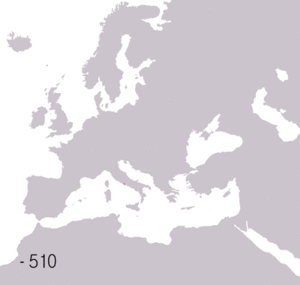
Dividing the Empire did not solve the problems for the Western part. It faced more and more attacks from the north. Tribes like the Ostrogoths, Huns, Franks, Visigoths, and Burgundians kept invading. To protect Rome, armies were pulled back from places like England and France.
Economic Challenges and Rising Taxes
The economy of the Western Empire struggled greatly. The government needed to spend a lot more money on its military. This caused inflation, meaning prices went up for everyone. Citizens were unhappy because taxes were rising, and their money bought less.
Attacks on Rome and Its Capture
In 398 AD, Alaric and his Visigoths started attacking areas closer to the capital. By 410 AD, they had successfully attacked and looted the city of Rome itself. This was a huge shock to the Roman people. In 455 AD, another group, the Vandals, captured Rome. Finally, in 476 AD, the Goths took control of the capital.
The End of an Era
The Western Roman Empire officially ended in 476 AD. This happened when the leader of the Goths, Odoacer, removed Emperor Romulus from power. Odoacer then became the King of Italy. At this point, Roman control over the Western Empire was completely gone. By then, the Western Empire existed only in name. The emperor had no real military, financial, or political power left.
Related History Topics
Images for kids
-
The Roman Republic before the conquests of Octavian
-
The organization of the Empire under the Tetrarchy
-
Solidus of Emperor Honorius
-
Barbarian invasions and the invasion of usurper Constantine III in the Western Roman Empire during the reign of Honorius 407–409
-
The Western Roman Empire during the reign of Majorian in 460 AD. During his four-year-long reign from 457 to 461, Majorian successfully restored Western Roman authority in Hispania and most of Gaul. Despite his accomplishments, Roman rule in the west would last less than two more decades.
-
The city of Ravenna, Western Roman capital, on the Tabula Peutingeriana, a 13th-century medieval map possibly copied from a 4th- or 5th-century Roman original
-
Map of the Eastern Roman Empire in 717 AD. Over the course of the seventh and eighth centuries, Islamic expansion had ended Roman rule in Africa and though some bastions of Roman rule remained, most of Italy was controlled by the Lombards.
-
Romance languages, languages that developed from Latin following the collapse of the Western Roman Empire, are spoken in Western Europe to this day and their extent almost reflects the continental borders of the old Empire.
-
Bust of Emperor Maximian, the first Western Roman Emperor
See also
 In Spanish: Imperio romano de Occidente para niños
In Spanish: Imperio romano de Occidente para niños


